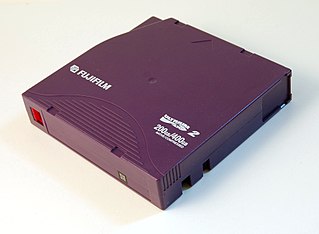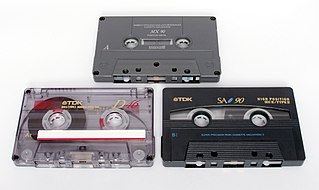This page is based on this
Wikipedia article Text is available under the
CC BY-SA 4.0 license; additional terms may apply.
Images, videos and audio are available under their respective licenses.

Magnetic tape is a medium for magnetic recording, made of a thin, magnetizable coating on a long, narrow strip of plastic film. It was developed in Germany in 1928, based on magnetic wire recording. Devices that record and play back audio and video using magnetic tape are tape recorders and video tape recorders respectively. A device that stores computer data on magnetic tape is known as a tape drive.

A vacuum cleaner, also known as a sweeper or hoover, is a device that uses an air pump, to create a partial vacuum to suck up dust and dirt from floors and from other surfaces such as upholstery and draperies.

The Compact Cassette, Compact Audio Cassette (CAC) or Musicassette (MC), also commonly called the cassette tape or simply tape or cassette, is an analog magnetic tape recording format for audio recording and playback. It was developed by Philips in Hasselt, Belgium, and released in 1962. Compact cassettes come in two forms, either already containing content as a prerecorded cassette (Musicassette), or as a fully recordable "blank" cassette. Both forms are reversible by the user.

An audio tape recorder, tape deck, or tape machine is a sound recording and reproduction device that records and plays back sounds usually using magnetic tape for storage. In its present-day form, it records a fluctuating signal by moving the tape across a tape head that polarizes the magnetic domains in the tape in proportion to the audio signal. Tape-recording devices include the reel-to-reel tape deck and the cassette deck, which uses a cassette for storage.

A magnetic stripe card is a type of card capable of storing data by modifying the magnetism of tiny iron-based magnetic particles on a band of magnetic material on the card. The magnetic stripe, sometimes called swipe card or magstripe, is read by swiping past a magnetic reading head. Magnetic stripe cards are commonly used in credit cards, identity cards, and transportation tickets. They may also contain an RFID tag, a transponder device and/or a microchip mostly used for business premises access control or electronic payment.

Linear Tape-Open (LTO) is a magnetic tape data storage technology originally developed in the late 1990s as an open standards alternative to the proprietary magnetic tape formats that were available at the time. Hewlett Packard Enterprise, IBM, and Quantum control the LTO Consortium, which directs development and manages licensing and certification of media and mechanism manufacturers.

Magnetic storage or magnetic recording is the storage of data on a magnetized medium. Magnetic storage uses different patterns of magnetisation in a magnetisable material to store data and is a form of non-volatile memory. The information is accessed using one or more read/write heads.
Utility software is system software designed to help to analyze, configure, optimize or maintain a computer. It is used to support the computer infrastructure - in contrast to application software, which is aimed at directly performing tasks that benefit ordinary users. Utilities often form part of application systems however. For example a batch job may run user-written code to update a database and may then include a step that runs a utility to back up the database, or a job may run a utility to compress a disk before copying files.
A recording head is the physical interface between a recording apparatus and a moving recording medium. Recording heads are generally classified according to the physical principle that allows them to impress their data upon their medium. A recording head is often mechanically paired with a playback head, which, though proximal to, is often discrete from the record head.

The ICT 1301 and its smaller derivative ICT 1300 were early business computers from International Computers and Tabulators. Typical of mid-sized machines of the era, they used core memory, drum storage and punched cards, but they were unusual in that they were based on decimal logic instead of binary.

A cassette demagnetizer is a device that removes the magnetic field that is built up from the use of audio cassettes in a cassette deck.

Chromium dioxide or chromium(IV) oxide is an inorganic compound with the formula CrO2. It is a black synthetic magnetic solid. It once was widely used in magnetic tape emulsion. With the increasing popularity of CDs and DVDs, the use of chromium(IV) oxide has declined. However, it is still used in data tape applications for enterprise-class storage systems. It is still considered by many oxide and tape manufacturers to have been one of the best magnetic recording particulates ever invented.

Preservation of magnetic audiotape comprises techniques for handling, cleaning and storage of magnetic audiotapes in an archival repository. Multiple types of magnetic media exist but are mainly in the form of open reels or enclosed cassettes. Although digitization of materials on fragile magnetic media in library and information science is a common practice, there remains a need for conserving the actual physical magnetic tape and playback equipment as artifacts.
The Official National Lampoon Car Stereo Test & Demonstration Tape was a comedy album in cassette tape format which was put out by National Lampoon magazine in 1980. The album was a follow-up to the Official National Lampoon Stereo Test and Demonstration Record, which was released in 1974. The tape is however a completely different album consisting of new material.












